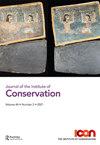Texel纺织品的发现被重新审视:历史上湿抹布的清洁和干燥过程的测试
IF 0.5
0 HUMANITIES, MULTIDISCIPLINARY
引用次数: 1
摘要
摘要2016年,一项独特的17世纪丝绸服装考古发现成为世界新闻,这些丝绸服装是荷兰特塞尔附近一艘沉船上的无数丝绸碎片。2017年,人们发现部分发现仍然潮湿,这为研究这类材料的受控冲洗和干燥方法提供了一个独特的机会。由此产生的研究项目的目的是在尽可能短的时间内找到一种处理方法,它不仅可以挽救这些零碎且非常退化的丝绸纺织品,还可以确定哪种处理方法最适合处理任何类似的发现。在原材料样品上测试了四种漂洗剂、漂洗方法和干燥技术。在测试的方法中,用细而可控的水流冲洗产生了最好的清洁效果,但由于其机械作用,它也造成了最大的材料损失。干燥实验在微观层面上没有产生纤维条件的显著差异,由于材料的不均匀性和纤维表面的严重损伤,任何变化都不明显。然而,冷冻干燥的样品仍然比那些经过空气干燥的样品具有更大的灵活性,并且变形和皱折也更少。尽管这项研究没有提供任何明确的“最佳”治疗组合,但它确实深入了解了所选方法的风险和优势,从而能够更好地选择知情的治疗方法。因此,对潮湿丝绸的最终处理包括将其分离、抹平,并使用可控的水流仔细冲洗两侧。然后将整个收集物冷冻干燥,结果成功保存了大约60个片段。本文章由计算机程序翻译,如有差异,请以英文原文为准。
The Texel textile find revisited: the testing of cleaning and drying processes for historical wet rags
Abstract In 2016, a unique archaeological find of seventeenth-century silk clothing in the form of countless pieces of silk from a shipwreck off Texel, in the Netherlands became world news. In 2017 it was discovered that part of the find had remained damp, and this presented a unique opportunity to conduct research into controlled rinsing and drying methods for this type of material. The aim of the resulting research project was to find a treatment—in as short a time as possible—which would not only save these fragmentary and very degraded silk textiles, but also establish which treatment method would be most suitable to deal with any similar find. Four rinsing agents, rinsing methods and drying techniques were tested on samples of the original material. Of the methods tested, rinsing with a fine and controlled stream of water produced the best cleaning results, but due to its mechanical action it also caused the greatest loss of material. The drying experiments produced no significant differences in fibre condition at a micro-level, with any changes unnoticeable due to the heterogeneous character of the material and the very damaged surface of the fibres. However, freeze-dried samples remained significantly more flexible than those which had been air-dried and were also less distorted and crumpled. Although the research did not provide any definitive ‘best’ combination of treatments, it did offer insight into the risks and advantages of the chosen methods to enable a better-informed treatment choice. As such, final treatment of the damp silks involved their separation, smoothing and careful rinsing on both sides using a controlled stream of water. The entire collection was then freeze-dried and as a result around 60 fragments were successfully conserved.
求助全文
通过发布文献求助,成功后即可免费获取论文全文。
去求助
来源期刊

Journal of the Institute of Conservation
HUMANITIES, MULTIDISCIPLINARY-
CiteScore
1.50
自引率
0.00%
发文量
22
期刊介绍:
The Journal of the Institute of Conservation is the peer reviewed publication of the Institute of Conservation (Icon). As such, its aims reflect those of Icon, to advance knowledge and education in conservation and achieve the long term preservation and conservation of moveable and immoveable cultural heritage. The Journal provides a collective identity for conservators; it promotes and supports both the profession and professionalism. With international contributions on all aspects of conservation, it is an invaluable resource for the heritage sector. The specific aims of the Journal are to: 1. promote research, knowledge and understanding of cultural heritage conservation through its history, practice and theory 2. provide an international forum to enable and disseminate advances in research, knowledge and understanding relating to conservation and heritage 3. champion and support professional standards of heritage conservation in the UK and internationally 4. provide a permanent record of issues relating to conservation and heritage 5. be financially and operationally sustainable. To achieve these aims, the Journal invites contributions from all those involved in the conservation of cultural heritage and related activities. Areas of interest include understanding cultural heritage materials and their degradation; subject reviews and histories of cultural heritage materials and conservation treatments; new, innovative or improved approaches to conservation and collections care theory, practice, communication, management and training; case studies demonstrating new, innovative or improved approaches; and conservation in its wider context. Submitters are encouraged to demonstrate how their work is of practical application to conservation. To maintain professional standards and promote academic rigour, submissions of articles and shorter notices are subject to an anonymous peer review process.
 求助内容:
求助内容: 应助结果提醒方式:
应助结果提醒方式:


